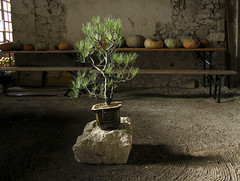 Driving from a foggy Pacific coast through vast valleys, mountains, high desert plains, then into higher alpine. Traversing caffeinated coffee frenzies to gentle herbal tea moments. Traveling for several days, visiting old friends, experiencing road rage, to no rage, then on to relaxed, peaceful cruising, below the speed limit.
Driving from a foggy Pacific coast through vast valleys, mountains, high desert plains, then into higher alpine. Traversing caffeinated coffee frenzies to gentle herbal tea moments. Traveling for several days, visiting old friends, experiencing road rage, to no rage, then on to relaxed, peaceful cruising, below the speed limit.Upon arriving at the Estes Park YMCA, with an 8000 feet elevation the sun felt so close and hot. Nine hundred others, monastic and lay friends, had also converged here to teach or receive a diagnosis and potential cure for their maladies.
Expectations were high as we first congregated into the hall for an orientation of how to live together for the next five days. All at once during the presentation we were struck and saddened to hear that the beloved teacher was ill, back in a Massachusetts hospital with a lung infection. Out loud his letter was read. He would not attend his own retreat. Huge thunderclouds formed, and then opened up onto us. Downpours formed not just from the sky, but from our eyes, soaking our clothes, soaking our hearts. How would he heal? How would we? Should we stay or go? Only a few left.
Nevertheless in this teacher’s illness, a model of well-being was demonstrated. Even with a lung infection, remember to, “breathe, you are still alive.” “There are already more than enough conditions of our happiness present.” “Look deeply for the source of ill-being.” Make a personal diagnosis. Taste the truth cultivated with mindful awareness, concentration and insight. As our teacher responsibly accepted his diagnosis and received a full course of antibiotics, monastic friends offered insightful talks and lessons with words of joy, hope and healing. We experience Thây through his continuation, his students. We accepted this bell of mindfulness; impermanence. Thây’s presence in the words of the dharma talks, in the solid presence of lay OI members and other practitioners, new and old and in the magnificent setting. A huge get well card was signed by the sangha and sent to the teacher.
Within just a few days, experienced friend’s skillful techniques mixed together with new friend’s freshness in the crisp mountain air, creating supportive conditions for healing and transformation. Mindful, loving energies ripening in the Rockies. Expansive space, present in such a grand natural view of sky and earth, eased our letting go of pain; untying our internal knots. Simple awareness of breaths facilitated touching of true happiness and joy.
With the Rockies’ grandeur as witness, I beheld that “this is it;” this is such a wonderful moment to be alive. New friends shared loving speech and deep listening. Held in compassion, hearts that suffered greatly were healing and were again feeling whole. I could see it in the faces and hear it in the words. The sweet community came together as a sangha, as one flowing river. There I was living and practicing together with friends in harmony.
Perhaps it was the thin, high-altitude air which also enhanced my awareness of breathing. Aahhhh, breathing in is noticeably a little more difficult, breathing out I smile to be breathing. During a soulful “be-in” the sangha sang, performed skits, joked and shared their joy with much talent. I saw the cloud in my tea. I also saw myself as the cloud’s continuation. My neighbors to me became beautiful continuations of their ancestors –people, animal, plant and mineral.
Prepared to depart from the retreat for California I have a clearer eight-fold path of therapy, including a mindful consumption diet. I also have new hope for a future to be possible, for myself, for all beings. I’m no longer a patient without a diagnosis. I clearly see that I am a victim of my own habit energy. My diagnosis: “Ill-Being Addict” or IBA. I’m captivated by my own suffering in a sad co-dependency relationship. It hurts so much but I don’t let it go. And I realize I’m not the only one with IBA. With this new insight I feel good about taking the mindful medicine; to be more happy, loving and accepting of myself and others. To really see the brilliant mountain sunrise of each new day as mindfulness bells. To pay attention to my in and out breaths.
Just before driving off I’m told that Thây is recovering from his infection and that he should be present at the California retreats in September. I wonder, is my healing helping the teacher? Perhaps, such is the nature of interbeing. Student and teacher, water and wave, song and bird, the one in the all, and the all in the one. One Buddha is not enough was instructed and experienced. With a sound of the bell I encounter “no separate self”, at least for the moment. Then an idea pops up, it would be touching to see Thây at Deer Park Monastery. Breathing in I recognize a thought about the future has manifested. Breathing out, I'm back in the mountains. In Colorado the miracle of mindfulness is recognizing that the time is now. What a wonderful thing to learn, again, fresh in this present moment.








